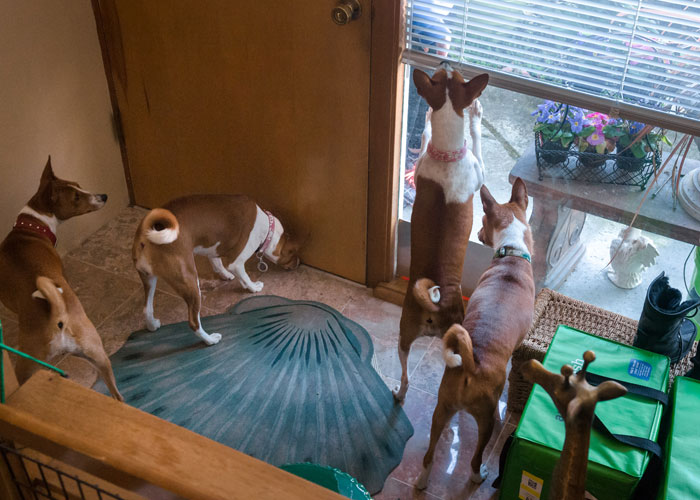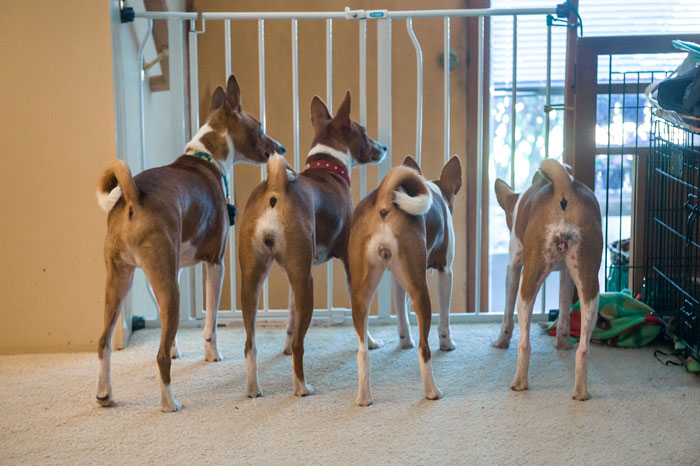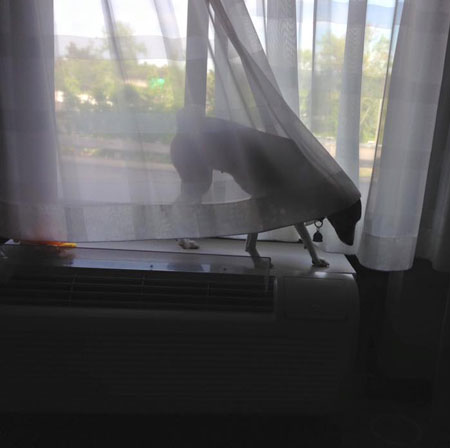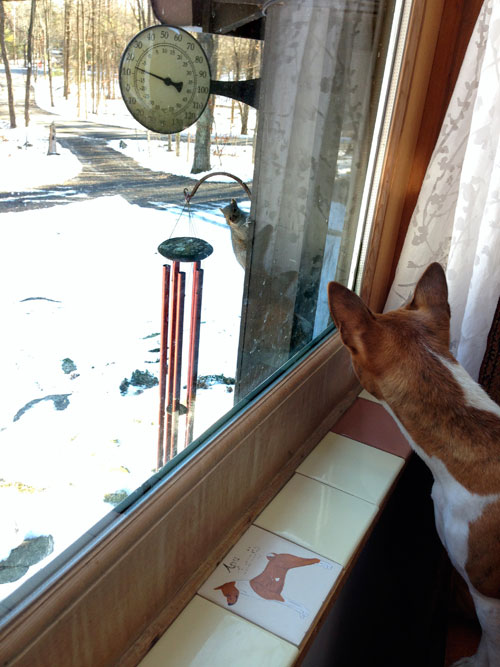Page 10 < previous page > <next page>
If They Don’t Bark, How Do You Know Someone’s at the Door?
by Marcia Woodard
Basenjis Nov 2015—AKC Gazette - reprinted, with permission
WE ARE SO PROUD! MARCIA WON HER 1st MAXWELL!

Winner in 'Humor", DWAA 2016 Writing Competition
If They Don’t Bark, How Do You Know Someone’s at the Door?
I am often asked the above question by people who have never lived with a Basenji and appear skeptical of the breed’s watchdog capabilities. “Oh, you’ll know,” I assure them. “They breathe hard and run around.” Of course this sounds completely lame, and I’ve only cemented their doubts.
I need to do a better job of describing the Basenji home-security system, for the sake of not only the breed but also my pride, so I solicited details from fellow fanciers.

Chez Woodard
“You mean when they run up and ricochet off you?” responded fancier Laurie Gregory. “Then ricochet off the door and come flying back to you--is that what you’re talking about?” Both the human and the door serve as a backstop in a repeating loop that’s a physical interpretation of “Someone’s here, someone’s here, someone’s here! Door, door, door!” The dogs pant, whine, and squeal--and if hardwood floors are involved, the scrabbling of toenails to gain traction, especially when drifting around a corner, adds to the drama.

Chez Woodard
Sometimes physical injury—to the fancier—is a side effect of Basenji security. Brenda Phillips describes a common scene on her living room couch with her bitch Lucy sleeping in her lap and her dog Nike curled next to her: “How do I know someone is at the door?” I can tell from the burning scratches Lucy leaves on my thighs when she takes off at breakneck speed. If that doesn’t do it, the smack to my chin when Nike’s head pops up surely does. Sadly, they don’t distinguish well between a doorbell on television and a doorbell in real life.”
Some furniture, because of its location, is not safe for occupancy. Fancier Dave McMahon’s couch serves as a viewing perch for the driveway, so if someone approaches the house, “there’s a mad scramble for the couch, “ said Dave, “and you’ve got five Basenji butts lined up to look out the window.” (Luckily, Basenjis have cute butts, as the breed is known for this type of “window shopping.”) Dave continued, “Then they rotate down—in a kind of staggered dismount—and race to the front door and circle back. It’s a hazardous seating area.”
 More chez Woodard
More chez Woodard
Stranger danger. With Basenjis, you’ll often know if the visitor is friend or foe before you answer the door. Fancier Marian Sweeney describes her dogs’ reaction if the person knocking is an unknown: “After dashing around, they circle in front of the door with hackles up, sniffing and huffing like big silverback gorillas. If one accidentally bumps into another, a major snark and snap session breaks out.”
At the home of fancier Catherine Charles, her dogs’ escalating levels of reaction let Catherine know who’s there. The dogs can see the driveway through the big picture-window in the living room, and when someone arrives, three dogs’ heads poke past the sheer curtain panels to assess the situation.

HIE
Level One--Low: a stranger approaches the front door. The dogs squeak, stand on their hind legs, and scratch and pummel the glass while working their way back and forth on the window. When they take off for the door, they leave the curtain panels fluttering in the wind.
Level Two--Medium: a family friend approaches the front door. Reaction similar to above except that the paw action and back-and-forthing on the window pick up speed and the squeaking is augmented by squealing. The curtains are blasted nearly horizontal when the pack speeds to the door.
 Chez Apu
Chez Apu
Level Three--High: Aunt Pam, with Beggin’ Strips in her pocket, approaches the front door. The reaction, in Catherine’s words: “Squeaking, squealing, and shrieking followed by the diva bitch grabbing the bottom of one of the curtain panels, pulling it out across the room, and shaking and killing it until the panel is ripped to the floor.” Next comes what Catherine calls “happy laps” and others call the “Basenji 500”: an adrenalized circular pattern in which Basenjis move so fast they merely glance off furniture, people, walls, windows and doors and appear airborne.
In comparison, barking seems kind of one dimensional.

More chez Apu.